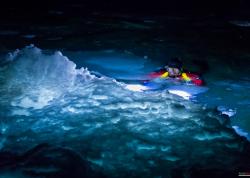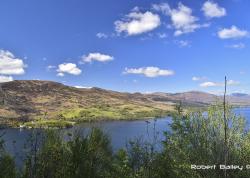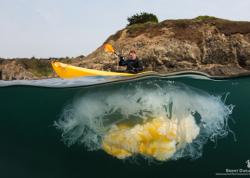Diving into History: The Flooded Farms
Diving into History: The Flooded Farms
Exploring a Flooded Valley, Farmhouse Ruins and an Underwater Forest in Norway
Text and Photos By Christian Skauge

Once upon a time there was no lake, only a peaceful valley with a small river running through it. Then the mountain above it started to rumble and a big rockslide came crashing down. Lake Lygnstøylsvatnet was born.
In the narrowest valley on the Norwegian west coast, Norangsdalen, rockslides and avalanches are very common. But not all of them create beautiful dive sites where an underwater photographer can frolic among remains of old dairy huts and the trees of a flooded forest.
In 1908, a huge rockslide closed off the small river Lygna, in Norangsdalen, and the water soon started to rise. After a few hours it became clear that it wouldn’t stop anytime soon and the farmers gathered the animals and their belongings and headed for safety further down the valley.

Remains of the old farmhouses in Lygnstøylsvatnet at 3 meters depth.
Nikon D300s, 10-20mm rectilinear, f/3.5, 1/160s, ISO 200
The long name of the lake is composed of three words - the river Lygna (meaning slow or quiet), støyl (a mountain summer pasture) and vatnet, which simply means lake. Luckily, you don’t have to pronounce the name to shoot some great images here.
Spectacular Scenery
Apart from being a great place to rinse your gear after diving in the ocean, lake Lygnstøylsvatnet offers spectacular scenery and often-great visibility – sometimes 40+ meters.
The lake bottom holds the remains of ten old farmhouses. The shallowest are found at just 3 meters depth and can be seen from the surface even before you enter the water.

Divers exploring the dairy hut remains in the lake.
Nikon D200, 10-20mm rectilinear, f/5, 1/90s, ISO 100
Between the pastures there are rock fences, and at the very bottom the road runs next to the old riverbed, complete with the milestones still standing.
The best visibility is usually found in April or May, as soon as the winding mountain road opens after the winter. The lake is even prettier in late summer or fall when the bottom is covered in a lush green blanket of algae, but the trade-off is visibility.

The bottom is beautifully covered in green algae in late summer and fall.
Nikon D300s, 10.5mm fisheye, f/4.5, 1/200s, ISO 400
Straightforward Wide-Angle
There is not too much to be written about how to shoot images in a shallow lake like this. To a certain extent the quality of your images is determined by the visibility – but even in less than optimal conditions there is plenty to play with in terms of light and shadow and the eerie scenery.

The remains of an old gate in one of the rock fences.
Nikon D200, 10.5mm fisheye, f/4, 1/250s, ISO 125
Basically we’re talking relatively straightforward wide-angle shooting here, very often without strobes – at least it you want to capture those big underwater landscapes.
There is not much other than greens and browns in terms of color, and I often find strobes redundant. In clear water, adding a little extra ISO may help you achieve a stronger blue in your backgrounds.

The last remains to be discovered in the lake showed up in the summer of 2012.
Nikon D300s, 10.5mm fisheye, f/5, 1/160s, ISO 400
One thing that may cause a problem is the depth, or more accurately the lack thereof. All the cool stuff in the water is at 12 meters or shallower and you may quickly run into problems with the dynamic range of your camera sensor.
The images very often burn out at the top, especially if you shoot portrait (tall) images on a sunny day. Watching your angle and (of course) the histogram is very important as the amount of light hitting the sensor changes dramatically even with the slightest change in tilt.

Dramatic landscape with trees and boulders from an ancient rockslide.
Nikon D300s, 10-20mm recilinear, f/5, 1/60s, ISO 640
The trick is usually just to remember to shoot with the sun behind you – but even so, the big difference between light at the top and at the bottom of the frame may present challenges. Some of the scenes can be shot from above, which very effectively solves this problem, but you might instead end up with your own shadow in the image.
Sunballs and Light Rays
The moderate depth on the other hand allows for several different lighting opportunities. You can crank up the F-stop and play with sunballs or turn the shutter speed up and try to capture those beautiful shafts of light that occur when sunlight hits water.

Catching light shafts is easy - but watch out or the image will burn out at the top.
Nikon D200, 10.5mm fisheye, f/4.5, 1/80s, ISO 125
No matter what you choose, you be mesmerized by the magic scenery and all the photo opportunities that present themselves. The scenery is breath-taking and eerily quiet, and at no other time is diving more like flying than this; soaring weightless above the bottom like a giant bird.
The Flooded Forest
In the southern end of the lake you enter the magical realm of the flooded forest. Before you know it, you are surrounded by old trees with naked branches stretching towards the surface.

Old trees stretching for the surface make interesting subject matter.
Nikon D200, 10.5mm fisheye, f/4, 1/250s, ISO 125
They sometimes look twisted and tormented and sometimes slender and peaceful. Often, algae hangs from the branches like dark veils, hiding what lies beyond. The feeling is eerie and even a little scary. Thoughts of trolls and underwater creatures not of this world easily come to mind.
Diving in Lygnstøylsvatnet is an unforgettable experience, and the resulting images are often unlike what most underwater photographers have in their portfolio.
Lens Choices
I usually choose to go with either a 10.5 mm fisheye or a 10-17 mm fisheye zoom lens, but I’ve also had good results using a Sigma 10-20 mm rectilinear wide-angle zoom lens, which doesn’t curve the edges of the image.
The shallow depth dives you plenty of time to explore and discover and you can even surface to change lenses or to get your bearings straight if you’re looking to return from where you came.
As an added bonus, you don’t have to worry about rinsing your camera rig when you’re done – that’s pretty much taken care of!
FACTS ABOUT LYGNSTØYLSVATNET:
Lygnstøylsvatnet is located on the Norwegian west coast, not far from the small town of Ørsta. The lake came into being after a rockslide in 1908, and today it offers one of the most spectacular photo dives in Norway.

An old image showing the dairy farm as it was before the rockslide in 1908. Photo by A.B. Wilse shot prior to the rockslide, reproduced from an info sign at the lake.
Link to Google maps:
About the Author
Christian Skauge is a former Nordic Champion of underwater photography and has won several international photo contests. He writes articles about diving and underwater photography and is published regularly in magazines around the world. He also runs underwater photo and marine biology workshops. Check out his website for more info: www.scubapixel.com
Further Reading
Swim with Orcas & Dive in Norway with Bluewater Travel
-
Diving Into Egyptian History: Cleopatra's Palace
-
The Secrets of Shooting Amazing Patterns
-
Nudibranch Safari in Gulen, NORWAY
Where to Buy
Please support the Underwater Photography Guide by purchasing your underwater photography gear through our sister site, Bluewater Photo & Video. Click, or call them at (310) 633-5052 for expert advice!
RECOMMENDED ARTICLES
SUPPORT THE UNDERWATER PHOTOGRAPHY GUIDE:
The Best Service & Prices on u/w Photo Gear
 Visit Bluewater Photo & Video for all your underwater photography and video gear. Click, or call the team at (310) 633-5052 for expert advice!
Visit Bluewater Photo & Video for all your underwater photography and video gear. Click, or call the team at (310) 633-5052 for expert advice!
The Best Pricing, Service & Expert Advice to Book your Dive Trips
 Bluewater Travel is your full-service scuba travel agency. Let our expert advisers plan and book your next dive vacation. Run by divers, for divers.
Bluewater Travel is your full-service scuba travel agency. Let our expert advisers plan and book your next dive vacation. Run by divers, for divers.
































